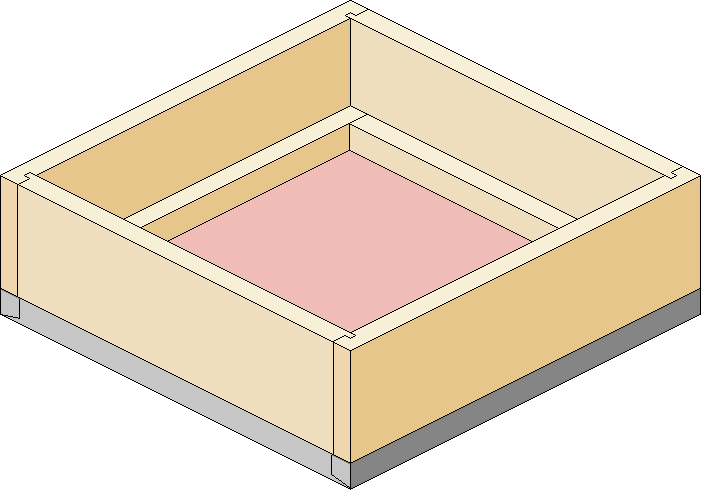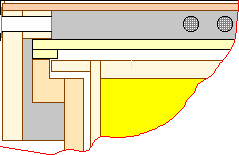This is shown upside down to show the inner rim. It is also shown with no ventilation.

There are many variations to this basic form:-
Dimensions... The overall depth can be anything from 75 mm to 300 mm and many different arrangements have been used for ventilating the space that occurs above a crown board when the roof is in position on top of a hive. Generally the parts that form the skirt are of 18 mm or 19 mm thickness, but 12 mm plywood can also be used. The size of the roof should be such that there is adequate clearance between the inner faces of the skirt and the outer faces of the hive boxes (9 mm to 13 mm all round is adequate). The roofs that I made at APEX Enterprises were 514 mm square overall and were nominally 150 mm or 255 mm deep.
The depth of the skirt will depend on your prevailing weather. The deeper versions being much heavier and less likely to be blown off by wind.
The corner joints may be comb jointed (and often are), but the form of joint illustrated is less likely to allow in water for decay, particularly if building adhesive is used.
The glue that I have used in the past was a waterproof grade of PVA, if I were ever to make any more of this type of roof I would use the 'no nails' type of building adhesive. I have used nails and screws in the past and find screws produce a more robust finished item.
I usually paint the woodwork with exterior grade gloss paint which I do before the metal top skin is added.
The sheet metal protective cover is spangled galvanized and has a thin sheet of expanded polystyrene foam (styrofoam) between it and the plywood top skin. This helps to stop transmission of heat when full sunlight falls on the metal top.
 The inner rim is usually in the range of 30 mm to 40 mm.
The inner rim is usually in the range of 30 mm to 40 mm.
One of the most common ventilation methods is shown in the sectional sketch at right. The section has been taken through one of the pair of 22 mm holes that can be in all four sides or just in two opposing ones. The outer apertures are usually masked with small pieces of '8' mesh to stop access by robber bees and wasps.
Most designs of roof are suitable for both top and bottom bee space use. There is a design that I developed for top bee space use that can be adapted to normal British Standards by adding a rim. One feature of this design is that it does away with the need for a separate Crown Board.